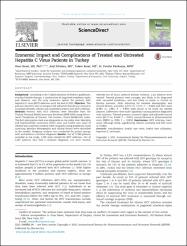Please use this identifier to cite or link to this item:
https://hdl.handle.net/20.500.11779/732| Title: | Economic Impact and Complications of Treated and Untreated Hepatitis C Virus Patients in Turkey | Authors: | Altinbaş, Akif Baser E Kariburyo, F Başer, Onur |
Source: | Baser O, Altinbas A, Baser E, Kariburyo F. (2015). Economic burden and complications of treated and untreated hepatitis C virus patients in Turkey. Defense One. C. 7, p. 42-48. | Abstract: | Background: According to the Turkish Ministry of Health’s guidelines,standard double therapy, a combination of pegylated interferon-alphaand ribavirin, was the only treatment option for patients withhepatitis C virus (HCV) infection until the end of 2011. Objective: Theprimary objective was to compare risk-adjusted clinical and economicoutcomes between treated and untreated patients with HCV infection.Methods: Patients with HCV infection were identified from theTurkish National Health Insurance Database (2009–2011) using International Classification of Diseases, 10th Revision, Clinical Modification codes.The first prescription date was designated as the index date. Mortalityand hepatocellular carcinoma (HCC) rates and health care costs oftreated and untreated patients were compared using propensity scorematching. Baseline demographic and clinical factors were controlledin the models. Subgroup analysis was conducted for patient groupswith and without a cirrhosis diagnosis. Results: Out of 12,990 patientsincluded in the study, 1,583 were treated for HCV infection. Out of2,467 patients who had a cirrhosis diagnosis, 231 were treated,whereas out of 10,523 patients without cirrhosis, 1,352 patients weretreated. Treated patients were younger, less likely to be diagnosedwith comorbid conditions, and less likely to reside in Central orEastern Anatolia. After adjusting for baseline demographic andclinical factors, mortality (2.27% vs. 5.31%; P o 0.001) and HCC rates(0.69% vs. 1.96%; P o 0.001) were found to be lower for treatedpatients. Differences were more significant among patients diagnosedwith cirrhosis. Treated patients incurred higher risk-adjusted annualcosts (€6172 vs. €1680; P o 0.001), mainly because of pharmaceuticalcosts (€4918 vs. €583; P o 0.001). Conclusions: HCV infection treatment, although costly, significantly reduces mortality and HCC ratesin Turkey. | URI: | http://dx.doi.org/10.1016/j.vhri.2015.08.004 https://hdl.handle.net/20.500.11779/732 |
ISSN: | 2212-1099 |
| Appears in Collections: | Ekonomi Bölümü Koleksiyonu PubMed İndeksli Yayınlar Koleksiyonu / PubMed Indexed Publications Collection Scopus İndeksli Yayınlar Koleksiyonu / Scopus Indexed Publications Collection |
Files in This Item:
| File | Description | Size | Format | |
|---|---|---|---|---|
| onur.pdf | Yayıncı Sürümü - Makale | 623.69 kB | Adobe PDF |  View/Open |
CORE Recommender
SCOPUSTM
Citations
4
checked on Nov 16, 2024
Page view(s)
36
checked on Nov 18, 2024
Download(s)
10
checked on Nov 18, 2024
Google ScholarTM
Check
Altmetric
Items in GCRIS Repository are protected by copyright, with all rights reserved, unless otherwise indicated.